Labor Practices
Occupational Health and Safety
KPI
Responsible Departments
Stance and Target
Review of FY 2021 Activities
Introduction of Initiatives
Issues and Future Improvement Measures
KPI
Move the screen to the left or right to see the table information
| Item | FY 2020 results | FY 2021 results |
|---|---|---|
| Lost-time injury frequency rate (global, directly employed) |
(Consolidated) 0.20 Domestic 0.31 Overseas 0.15 |
(Consolidated) 0.18 Domestic 0.45 Overseas 0.07 |
| Scope of application of Occupational Health and Safety Program | 100% | 100% |
| Number of workers with a high risk of accident or illness | Zero | Zero |
| Formal agreement with labor unions regarding occupational health and safety matters | Yes (at those business locations where there is a labor union) |
Yes (at those business locations where there is a labor union) |
Responsible Departments
Each business location
- Activities are conducted by each business location, and the Central Committee of Safety and Health that the Safety and Health Management Department serves as a secretariat implements company-wide policy discussions and activities.
Stance and Target
Why is “Occupational Health and Safety” a critical issue to be addressed?
Explanation of the reason and background
We believe that for workers to be able to work in a secure and safe manner serves as the foundation for operations. As regards work-related accidents at the Yokohama Rubber Group in Japan and overseas, while the frequency of occurrence is low when compared with the average occurrence frequency for the production and manufacturing sector as a whole, it is not zero. Analysis of the causes of such accidents has revealed that many of them could have been prevented by countermeasures taken in advance. Because it is necessary to handle large-scale machinery at production plants due to the nature of our business, this leads to the possibility of major accidents from defects in equipment specifications and mishandling, and for this reason safety countermeasures are necessary. In addition, due to factors such as the fact that mental health issues account for an increasing percentage of long-term absentees, we need to respond fully to not only physical health, but mental health as well. For this reason, at the Yokohama Rubber Group we have selected occupational safety and health as a critical issue to be addressed.
Supporting System for Safety and Health Management
In Japan, we formed a “Safety and Health Sub-Committee” at each division and workplace and the “Office-Wide Safety and Health Committee (legally stipulated)” at each office, under our Central Committee of Safety and Health that is headed by the CSR Department Manager. The importance of safety and health activities is recognized by both Group companies and unions. Through interaction with the Japan Rubber Manufactures Association and Japan Rubber Workers Union Confederation to share safety information with other companies and other union confederation members, we are also trying to facilitate collaborative action by labor and management. We also share our activities with our subcontractors by having them join their respective committees. As for our various overseas offices, they have their own supporting system in place according to the prevailing law under their country’s governance. The Safety and Health Management Department manages activities relating to safety and health both in Japan and overseas.
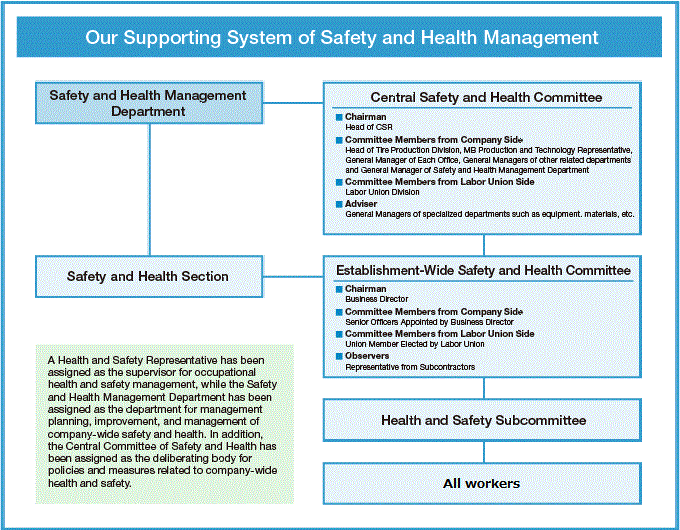
Vision (attainment goal) / target
- We will promote the creation of a safe and comfortable working environment and good health.
- We will establish a safety culture aiming for zero risks, and aim for zero work-related accidents.
Measures for vision achievement
We will implement the following seven measures to create workplaces that enable employees to work in a safe and healthy manner.
- Strengthening safety measures for equipment and work
Implement risk assessments for all equipment and work, and create facilities so that sources of danger cannot reach or be reached by human bodies, and prevention of recurrence of similar accidents. - Developing safety-conscious human resources
Conducting One-on-One education, to develop safe personnel.
Reinforcement of Stop-Call-Wait procedure and countermeasures in response to risk causes.
Implementation of KYT (Kiken Yochi Training / hazard prediction training), sampling and improvement of near-miss incidents, and hazard demonstration training in order to improve sensitivity towards risks. - Development of standard work manuals
Identifying unsafe places and unsafe behaviors and reviewing standard work through open work observation. - Promoting both physical and mental health
Strengthening mental health countermeasures (management of working hours, face-to-face guidance and work improvement suggestions for employees working long hours, education for improving communication skills through attentive listening training classes, and conducting stress checks). - Improvements in workplaces
Chemical risk assessment, personal protective equipment (PPE), equipment development, improvement of work methods, thorough implementation of 5S (seiri [tidiness], seiton [being organized], seisou [cleanliness], seiketsu [hygiene], shitsuke [discipline]), and improvement of high temperature work environment. - Prevention of traffic accidents
Conducting accident prevention activities and identifying risk points on commuting routes in order to achieve the target of zero accidents resulting in injury or death. - Establishment of a safety and health platform
Continuation and Spiral Up of Occupational Health and Safety Management System, development of training system for each level, enhancement of the checking function through top management diagnosis, safety patrols, safety diagnosis, and diagnostic follow-up.
Review of FY 2021 Activities
The following activities were conducted for the measures implemented in FY 2021.
1. Strengthening of facility measures
Risk assessments for all facilities and operations are conducted systematically and on an ongoing basis.
Therefore, we are operating a system to follow up monthly on the number of risks and improvements.
Top safety diagnoses were conducted at plants in Japan.
In addition, we are strengthening horizontal deployment of disaster countermeasures to prevent recurrence of similar disasters.
Therefore, we are operating a system to follow up monthly on the number of risks and improvements.
Top safety diagnoses were conducted at plants in Japan.
In addition, we are strengthening horizontal deployment of disaster countermeasures to prevent recurrence of similar disasters.
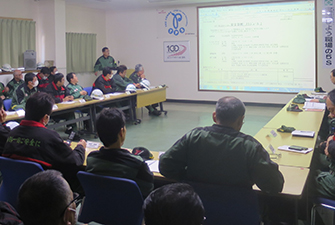
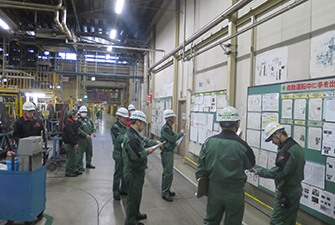
Safety diagnostics
2. Developing safety-conscious human resources
We aim to create people with the sensitivity to perceive hazardous events as dangerous. We are conducting KYT (Kiken Yochi Training / hazard prediction training), which is to be done by every worker every day, along with sampling and improvement for near-miss incidents, which constitute self-directed activities that we encourage everyone to participate in. We also conduct hazard simulation training in our "Taikan Dojo" (experiential training to prevent accidents).
In addition, supervisors talk one-on-one with workers until they are able to perform safe work on their own.
There, they are made to understand the meaning of each task based on ergonomics, and other communication is emphasized to raise safety awareness.
In addition, as people who work with us, partner employees also participate in activities to prevent the occurrence of disasters in an effort to improve safety levels.
In addition, supervisors talk one-on-one with workers until they are able to perform safe work on their own.
There, they are made to understand the meaning of each task based on ergonomics, and other communication is emphasized to raise safety awareness.
In addition, as people who work with us, partner employees also participate in activities to prevent the occurrence of disasters in an effort to improve safety levels.
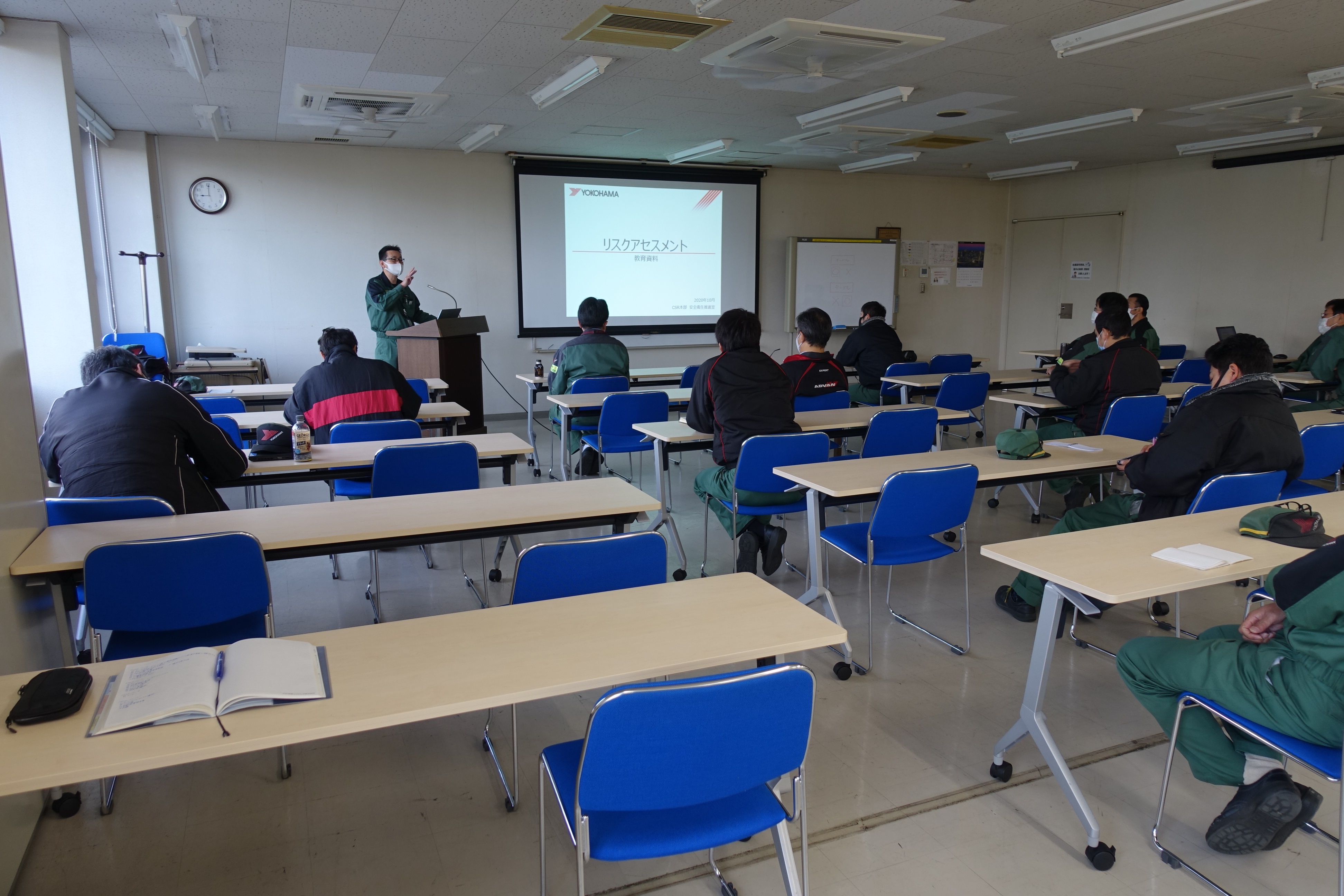
Risk assessment training

Hands-on safety drills with overseas plant safety personnel
(Hands-on experience of stairs with holding a load)
(Hands-on experience of stairs with holding a load)
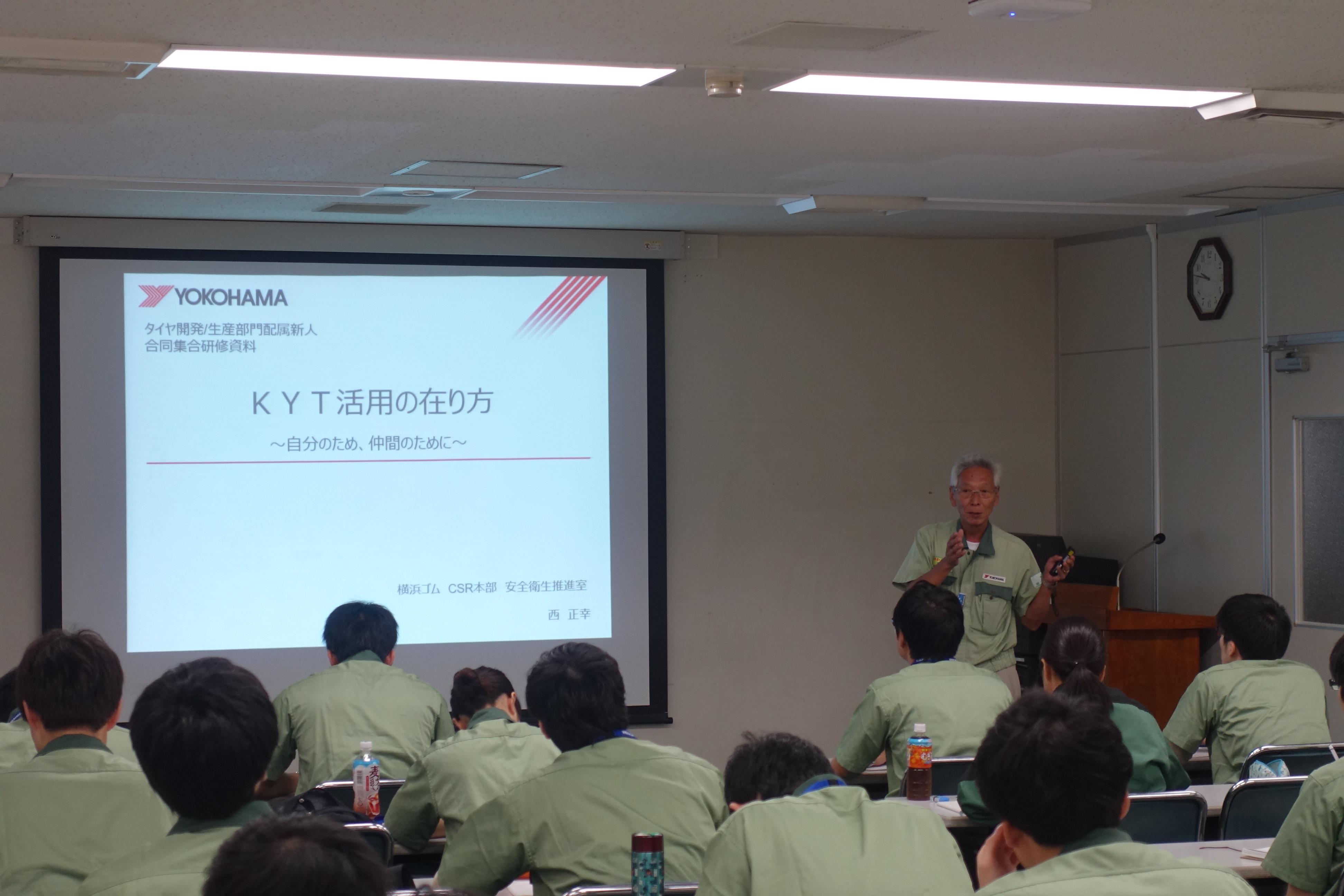
Newcomer KYT Training
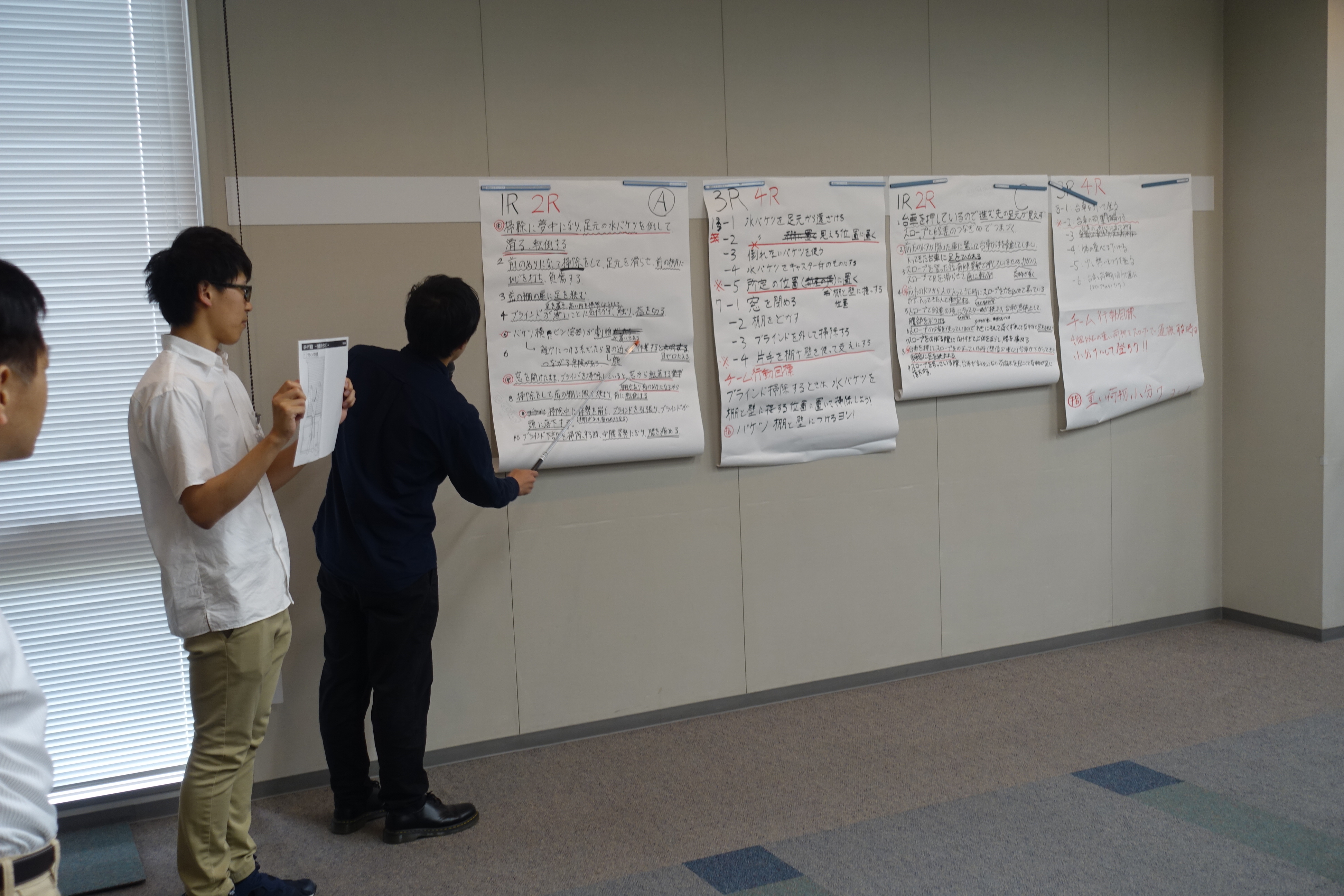
Techno-College
3. Development of standard work manuals
We conduct open work observation in a planned and ongoing manner, and identify unsafe places and unsafe behaviors and review standard work manuals.

Singing the Safety Chant together before beginning work.
4. Promoting both physical and mental health
Our efforts in mental health include management of working hours through a clocking in and clocking out system, face-to-face guidance and work improvement suggestions for employees working long hours, education for improving communication skills through attentive listening training classes, etc. In addition, stress checks were commenced from fiscal 2016. These checks are mainly for the purpose of assessing the level of stress of employees and encouraging employees to notice their own stress levels in order to lead to improvements in the workplace and encourage the creation of ideal working environments, which will prevent mental health issues among employees (primary prevention).
For the reinstatement of long-term absentees who have been absent due to mental health reasons, we hold interviews with the employee involved, and confirm the situation with family physicians, industrial physicians, public health nurses, and the workplace in order to discuss matters such as the means of reinstatement, timing, and work limitations in order to achieve a well-planned reinstatement. Reinstatement has been achieved at the Head Office and Hiratsuka in cooperation with the Jikei University Hospital and three industrial mental health physicians, which is still a relatively rare situation.
Furthermore, after reinstatement, regular three-party interviews are held between employees, industrial physicians, and workplace representatives in order to gradually loosen work limitations and provide follow-up until all restrictions have been fully released.
In addition, we also conduct activities that support smoking cessation of employees to promote health, and physical fitness seminars.
For the reinstatement of long-term absentees who have been absent due to mental health reasons, we hold interviews with the employee involved, and confirm the situation with family physicians, industrial physicians, public health nurses, and the workplace in order to discuss matters such as the means of reinstatement, timing, and work limitations in order to achieve a well-planned reinstatement. Reinstatement has been achieved at the Head Office and Hiratsuka in cooperation with the Jikei University Hospital and three industrial mental health physicians, which is still a relatively rare situation.
Furthermore, after reinstatement, regular three-party interviews are held between employees, industrial physicians, and workplace representatives in order to gradually loosen work limitations and provide follow-up until all restrictions have been fully released.
In addition, we also conduct activities that support smoking cessation of employees to promote health, and physical fitness seminars.

Stress check study session at Onomichi Plant
Health Promotion Activities at Mie Plant

Labor-management co-sponsored hikes
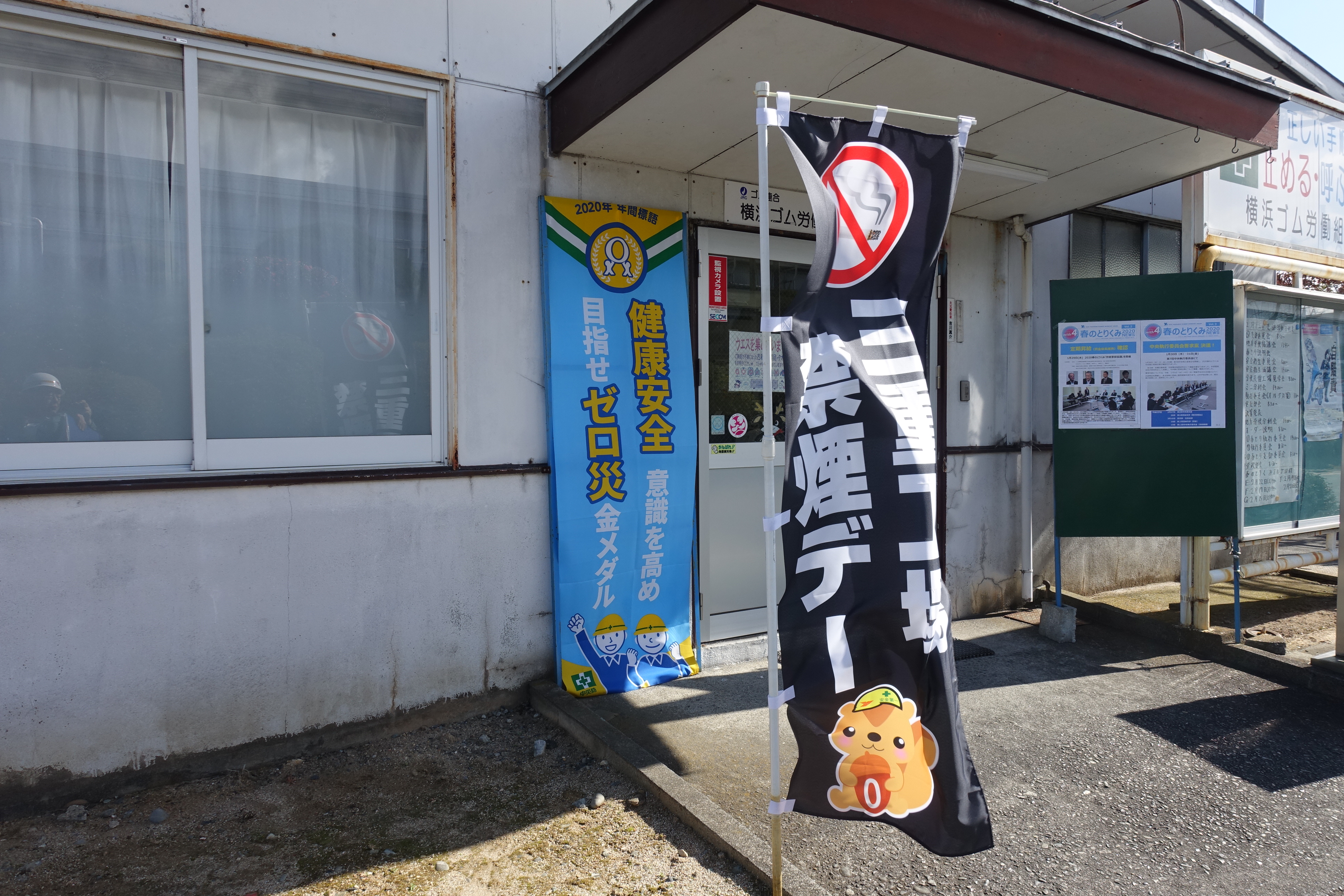
No Smoking Day at the Mie Plant
5. Improvements in workplaces
We have improved equipment and promoted the improvement, maintenance, and management of working methods aimed at using working environment measurements in order to maintain a pleasant workplace. In addition, based on the 5S (seiri, seiton, seisou, seiketsu, and shitsuke, or sorting, straightening, systematic cleaning, standardizing, and sustaining) methodology, we promote manufacturing where the things you need are available in a location that is not unsafe when you need them.
In recent years, we have experienced "life-threatening heat.
As "heat stroke is a disaster that can lead to death as well as injury," we are measuring WBGT values in workplaces and taking measures to reduce them, such as by venting hot air.
In recent years, we have experienced "life-threatening heat.
As "heat stroke is a disaster that can lead to death as well as injury," we are measuring WBGT values in workplaces and taking measures to reduce them, such as by venting hot air.
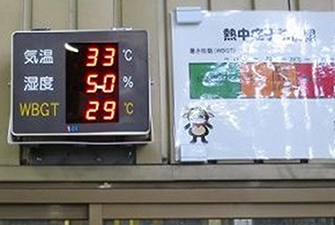
Visualization of working environment with a WBGT measuring instrument
6. Preventing traffic accidents
Each business locations conducts awareness raising activities while cooperating with the holding of traffic safety seminars with local police stations and traffic safety related organizations. In addition, we are working to raise traffic safety awareness through education using drive recorders and by calling out to drivers at their gates.
7. Establishment of a safety and health platform
We have acquired Occupational Safety and Health Management System (JISHA/OSHMS/ISO45001) certification at 17 domestic and overseas business locations; during fiscal 2021, we renewed certification at six other locations (the certification process is ongoing at other business locations).
We will continue to improve management systems and implement the PDCA (plan, do, check, action) cycle as we work to enhance our safety and health infrastructure.
We will continue to improve management systems and implement the PDCA (plan, do, check, action) cycle as we work to enhance our safety and health infrastructure.
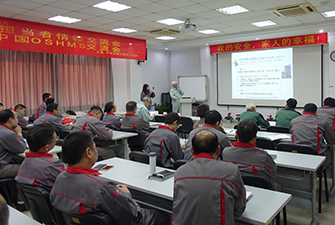



The frequency of occupational accidents was 0.18. We will be working to achieve the target of zero accidents and also to realize zero risks.

Frequency of Occupational Accidents (Lost-time injury frequency rate)
Explanation of the numbers
- Lost-time injury frequency rate = (number of work-related injuries / total working hours) x 1,000,000 hours
- All data are annual aggregated values (January to December)
- Figures for all production industry (excluding general contracting) and manufacturing industry are based on the Survey on Industrial Accidents statistical table released by the Ministry of Health, Labor and Welfare
Introduction of Initiatives
In April 2019, we held a safety exchange meeting with Central Japan Railway Company (JR Tokai) at our Mie Plant. Through safety and health exchange meetings with other companies, we are working to improve the level of safety and health of both companies.
In addition, employees belonging to Onomichi Plant's Safety and Health Division received the Green Cross Award at the National Industrial Safety and Health Convention held in October 2019. The award is in recognition of their daily efforts in health and safety activities.
In February 2020, a meeting of safety staff was held at the Mishima Plant. Representatives from each plant in Japan and related parties gathered for a lively question and answer session on safety measures.
In addition, employees belonging to Onomichi Plant's Safety and Health Division received the Green Cross Award at the National Industrial Safety and Health Convention held in October 2019. The award is in recognition of their daily efforts in health and safety activities.
In February 2020, a meeting of safety staff was held at the Mishima Plant. Representatives from each plant in Japan and related parties gathered for a lively question and answer session on safety measures.
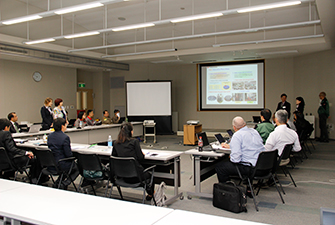
Announcements on safety activities by employees from each plant
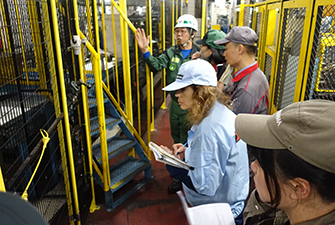
Observed equipment safety measures

JR Tokai exchange meeting
Issues and Future
Improvement Measures
We are implementing various measures aimed at creating a safe and employee-friendly workplace environment, and at safeguarding employees’ health; however, the current situation is that we have yet to realize our goal of reducing the number of accidents to zero.
Besides proceeding with equipment-related measures that focus on maintaining distance from sources of danger, we are also working to cultivate employees who know how to act safely.
Besides proceeding with equipment-related measures that focus on maintaining distance from sources of danger, we are also working to cultivate employees who know how to act safely.


